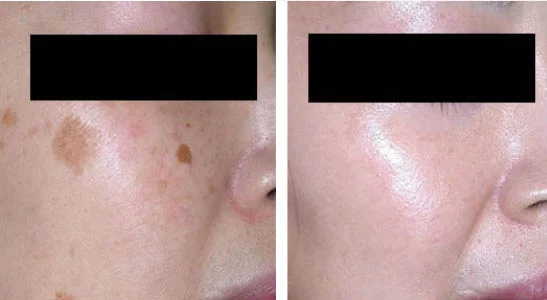A lentigo is a most common type of a lentigo problem (the plural form is lentigines or lentigos) is skin spot, generally it is brown in colour and it occurs as a pigmented flat or slightly raised skin lesion with an easily defined edge. Lentigines types are tan, black, or brown in colour with round or round shape, generally 5mm in size (may vary from 3-15mm in diameter).
Lentigines may affect both genders, men and women of all ages and races, though more common in fair skin people and for darker skin people it’s rare. Lentigines may occur on any part of the body of an individual. Lentigines usually are formed slowly over the months or years, but in sometimes may suddenly form. Unlike the other skin spots, it does not fade in the downtime month.
Triggering factors that contribute depends upon the type of lentigo, usually, the following reasons are considered:
Lentigines can grow to appear as single or in groups. Most lentigines are smaller than 5 mm in diameter.
Lentigo simplex is the most common type this often starts in early childhood or adult life and is the precursors of junctional nevi. They are present on your trunk, arms, and legs. These spots disappear over a time period in most cases. They are characterized by smooth or jagged edges and have a dry skin surface.
Solar lentigo is caused by exposure to ultraviolet radiation from the sun causing melanocytes in the skin to multiply. These are more common in people above 40 and are considered to be a precursor of seborrhoeic keratosis. Solar lentigines are called as liver spots or age spots. Solar lentigo appears on sun-exposed areas of the body, like the face, hands, shoulders, and arms. The spots may grow over time. They are very dry to touch with a faded outline and are yellow, light or dark brown in color and can be both, regular or irregular in shape.
Ink spot lentigo appears after sunburn in people who have lighter-pigmented skin. They are dark brown or black in color with irregular margins.
They are similar to ink spot lentigines and develop on areas exposed to PUVA therapy, which is used to treat chronic skin diseases such as psoriasis and eczema.
These are more commonly seen in cancer patients and lentigines appear in areas exposed to radiation.
Features are similar to ink spot lentigines and appear on parts of body exposure to the indoor tanning bed.
These tend to begin with small macules that later merge to form larger patches; noticed in children.
These are a naevoid eruption of lentigines confined to a single segmental area.
These patterned lentigines inherently develop on face, lips, buttocks, palms, and soles.
These are also called mucosal lentigines, as they develop over mucosal surfaces or to the adjacent glabrous skin like lip, vulva, penis, and anus. They are light to dark brown in color.
These are associated with mental retardation.
The inheritance is autosomal dominant and sporadic cases are common. Widespread lentigines are present at birth or arise in early childhood. This syndrome is associated with neural, endocrine, and mesenchymal tumors.
Following inherited syndromes can also be associated with lentigo are:
Dermatologist needs a detail assessment upon the cause, type and nature of the lentigenes before planning for a treatment. The treatment differs upon the nature of lentigo either is it a benign or malignant.
Benign lentigo Benign lentigines need treatment for their cosmetic appearance, as it doesn’t have any other health hazard. Treatments to lighten or remove lentigines are almost similar to freckles; lentigenes respond slowly to treatment.
We at Clear skin laser laser centre performs most advance laser treatments for lentigos to achieve good results in short time period with less down time. Though, sun protection and regular use of sunscreen is the best way to prevent from re-occurring of Lentigo.
Bleaching creams, containing hydroquinone and kojic acid, works better in combination with sun protection. Retinoids may be used in conjunction with other bleaching creams to enhance the lightening effect.
Chemical peels to lighten lentigenes.
Cryosurgery and Electrosurgery can destroy melanocytes.
Several types of lasers and light are quite safe, with a high success rate with extremely low risk in Laser treatments for Lentigines. Among lasers, Q-switched lasers are the gold standard, with the highest success rate in treating Lentigines. Intense Pulse Light (IPL) treatment is quite effective for another laser-based technique, to tackle freckles.
We at Clear skin laser centre has the highest success rate in treating Lentigines with the world’s most advanced Pico lasers
If there are any signs of malignant transformation of the lentigo, the below mentioned treatments are recommended:
The surgical removal of the tissue is slightly larger than the existing lentigo, to provide a safety zone. Prophylactic removal is performed; in the case of metastases, regional lymph nodes are removed through radical resection.
After surgical treatment, radiation therapy in large doses to be given in case of inoperable tumors.
With cytotoxic agents to inhibit tumor growth in un-operated cases which include multiple recurrences or metastases.
Drugs such as bleomycin, vincristine, and lomustine are administered to the patient to suppress the development of cancer cells in the lentigines.
This treatment deals with human interferons used in combination with other drugs to treat metastatic disease.
Gene therapy: This vaccinates and immunizes individuals against the tumor.
The following methods should be adopted to prevent the formation of lentigine
| DO | DON'T |
|---|---|
| Use daily broad-spectrum sunscreen with SPF more than 30+ | Don’t have Prolonged or overexposure to sunlight or ultraviolet rays |
| Use of wide-brimmed hats and sun-protective clothing to protect from UV rays | Don’t expose yourself to accidental radiation. |
| Do refrain from using tanning beds | Don’t expose yourself to artificial UV light |

